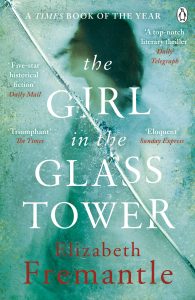Elizabeth Fremantle’s The Girl in the Glass Tower Explores the Invisibility of Women in History
JENNIFER QUINLAN
 In Elizabeth Fremantle’s fourth novel, The Girl in the Glass Tower, she departs the world of the Tudors to illuminate the life of Arbella Stuart, the tragic heir to Queen Elizabeth I. Thanks to her famous cousins, Arbella is often overlooked these days, yet that was not always the case. Several attempts to exploit her as a political pawn during a time ripe with plots and treason led to Arbella being closely watched and sequestered for most of her life.
In Elizabeth Fremantle’s fourth novel, The Girl in the Glass Tower, she departs the world of the Tudors to illuminate the life of Arbella Stuart, the tragic heir to Queen Elizabeth I. Thanks to her famous cousins, Arbella is often overlooked these days, yet that was not always the case. Several attempts to exploit her as a political pawn during a time ripe with plots and treason led to Arbella being closely watched and sequestered for most of her life.
“It is precisely because Arbella is so little known that I wanted to shed light on her story,” Fremantle explains. “In some ways my aim was for The Girl in the Glass Tower to work as a companion piece to my earlier novel, Sisters of Treason, as Arbella’s story so strongly echoes that of Lady Katherine Grey, though the two women had such different characters. Both figures encapsulate the challenges of women born close to the throne and the ways in which such a fate was more curse than blessing, something that has long fascinated me.”
Indeed, Arbella’s life as a virtual prisoner may look nothing like the lifestyle that comes to mind when one typically considers royalty, a contrast that Fremantle wanted to illustrate. “Culturally speaking, we have this idea of the privilege of royal blood as always bringing with it immense good fortune; this is what stimulates the pervasive desire of little girls to become princesses. Arbella’s story seemed to me like a dark fairy tale that turns that idea on its head.”
To bring Arbella to life on the page, Fremantle turned straight to the source. “Because of her political importance, many of Arbella’s letters have survived, which was a gift for me from the perspective of developing her character for fiction.” When asked how Arbella’s own words helped shape her character, a woman who often alternates between hope and despair, Fremantle elaborates. “I was surprised to see, through her handwriting, such strong evidence of her shifting mental state. Her writing is at times a perfect schooled hand and at others a wayward scrawl, sometimes in the same letter, which seemed to me to echo her state of mind. Mostly though, I was able to see her intelligence and ability as an imaginative writer.”

author photo by Phyllis Christopher
Fremantle also draws on the extant body of work of another woman, one arguably more famous than Arbella, thanks to some scholars and a recent trend in fiction to depict her as Shakespeare’s muse. Aemilia Lanyer dedicated a poem to Arbella. Focusing on a different side of Lanyer and on a different time in her life, Fremantle integrates some of her story into that of Arbella.
“. . . I chose to weave their stories together because I felt they chimed in tune across the social spectrum. Both women had a strong desire to be heard, and both harboured a rebellious streak that I found appealing. These are two themes to which I return constantly in my work and I felt that casting them together in this way helped to emphasize my message.”
When I asked about the decision to deviate from the popular theory of Lanyer’s involvement with Shakespeare, Fremantle explained, “I was not particularly interested in the romantic idea of Aemilia Lanyer as Shakespeare’s “Dark Lady”; it is the writer in her that fascinated me and the content of her writing that challenged the status quo in gender terms.”
In her author’s note, Fremantle describes the desire to explore “the invisibility of early modern women’s lives.”
“There is an assumption that early modern women were all meek and obedient all the time. You only have to scratch the surface of history to understand that this was simply not the case.” And to prove the point, several strong and unconventional women make appearances in Arbella’s story, like her grandmother, Bess of Hardwick; Penelope Rich, the Marchioness of Northampton; and even Queen Anna, who openly practiced her Catholic faith. “However,” Fremantle cautions, “what is true is that women had to carefully and subtly negotiate their power. For me this makes them all the more impressive. All my novels focus on aspects of this, and though I don’t pretend to fully understand, from the perspective of life in the 21st century, how those women might have felt about their restricted lives, I constantly seek to explore the invisibility of women in history.”
About the contributor: Jennifer Quinlan, aka Jenny Q, is an independent editor and cover designer specializing in historical fiction. Jenny studied history at Virginia Tech and copyediting at the University of California, San Diego. She writes reviews and interviews authors for her blog, Let Them Read Books, and for Romantic Historical Reviews. She also moderates the American Historical Fiction group on Goodreads. She lives in Virginia with her husband, a Civil War re-enactor and fellow history buff.






